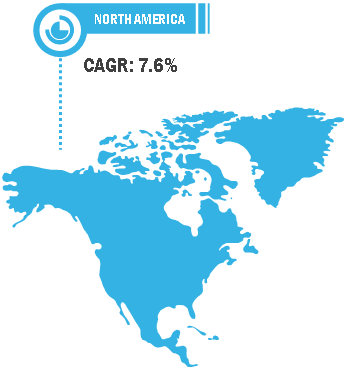Report : North America Destratification Fan Market Forecast to 2028 - COVID-19 Impact and Analysis by Installation (Open Ceiling and Grid Ceiling), Application (Retail, Warehouse & Distribution, Manufacturing Facilities, Agriculture & Livestock, Aviation, Offices, Hospitality & Hotels, and Others), and Sales Channel (On-line and Off-line)
Rapid Growth of End-Use Industries
North America Destratification Fan Market Forecast to 2028 – COVID-19 Impact and Analysis – by Installation (Open Ceiling and Grid Ceiling), Application (Retail, Warehouse & Distribution, Manufacturing Facilities, Agriculture & Livestock, Aviation, Offices, Hospitality & Hotels, and Others), and Sales Channel (On-line and Off-line). The destratification fan market was valued at US$ 204.9 million in 2021 and is projected to reach US$ 341.8 million by 2028; it is expected to grow at a CAGR of 7.6% from 2021 to 2028.
Increased population and improvements in residential infrastructure development enable massive growth contributors in the destratification fan market, thanks to technological advancements and the growing adoption of smart technologies. Thermal stratification has the main disadvantage of making heating, ventilation, and air conditioning (HVAC) systems work harder to maintain an even temperature. To combat the effects of thermal stratification, HVAC systems must over-deliver on hot or cool air. Extreme temperature differences are more likely in buildings with high ceilings. The wasted heat at the top of the building will invariably reach its peak or rise by up to 14 degrees Celsius, further raising the temperature.
The US and Canada are among the prime contributors to the North American destratification fan markets. In 2019, according to U.S. Energy Information Administration, the global emission of energy-related carbon dioxide was totalled 33,621.5 million metric tons while the United States emitted 5,130 million metric tons of energy-related carob dioxide, whereas Canada's total GHG emissions in 2019 were 730 mega tonnes of carbon dioxide. Therefore, the federal governments in North America are investing a massive amount of capital in reducing CO2 emission; thus, they are frequently investing in development and innovation products. For instance, the Canadian government has committed $60 billion to reduce greenhouse gas emissions, develop clean technologies, assist Canadians and communities in adapting to a changing climate, and protect the environment. The US Federal government is investing $62 billion in the US Department of Energy (DOE) to continue making clean energy more equitable. The US government's Bipartisan Infrastructure Deal supports the supply chain for batteries, a grant program to support advanced energy technology manufacturing projects in coal communities, and the DOE's Loan Program Office's (LPO) authority to invest in various energy-efficient projects. Therefore, with these governments' initiatives, there are many lucrative opportunities for the key vendors operating in the destratification market.
The North America destratification fan market is segmented into installation, application, and sales channels. On the basis of installation, the destratification fan market is divided into the open ceiling and grid ceiling. The open ceiling segment holds a significant amount of revenue shares in the market. The downstream demand markets are driving the growth of the destratification fan market. On the basis of application, the destratification fan market is segmented into retail, warehouse & distribution, manufacturing facilities, agriculture & livestock, aviation, offices, hospitality & hotels, and others. The office segment holds a significant amount of revenue shares in the market. Recent developments in fan technology, temperature control units, etc. are the major factors driving the adoption of destratification fans across North America. On the basis of sales channels, the destratification fan market is bifurcated into online and offline. The online, segment holds a significant amount of revenue shares in the destratification fan market..
The key market players or manufacturers in the North America destratification fan market include Zoo Fans Inc; Canarm LTD; Vents Us; Continental Fan; Delta T LLC; Airius, LLC; Air-Row Fan Company; Refresh Fans; Texas Electronics Canada Inc; and DRD System.
Impact of COVID-19 Pandemic on North America Destratification fan Market
COVID-19 has a negative impact on destratification fans market in North America. The demand for ventilation systems increased as medical facilities required cleaner, fresh air than ever before. Unfortunately, disrupted supply chains forced contractors to reconsider their worldwide supply networks, while the coronavirus itself forced companies to think about how to keep both employees and customers safe. According to some industry experts, April 2019 was the most difficult month for the HVAC business. According to HARDI (Heating, Air-conditioning, and Refrigeration Distributors International), between April 2020 and April 2019, the average distributor in the United States suffered a 19% drop in sales. Despite the fact that sales began to rise again in the summer of 2020, the unemployment rate was expected to continue to have a negative impact on the industry, as fewer firms were willing to invest on HVAC, especially with so many people out of work. The pandemic impacted construction as well as HVAC and other service-related sectors. According to a survey conducted by the American Institute of Architects (AIA) in September 2020, construction activity was predicted to decrease throughout the year and into 2021. Hotel construction was predicted to drop by more than 20%, while recreational and entertainment facilities would drop by 13%, offices by 11%, retail by 8%, and education by 7%..
North America Destratification fan Market Breakdown – by Region, 2020

Contact UsContact Person: Sameer Joshi
Phone: +1-646-491-9876
Email Id: sales@businessmarketinsights.com
